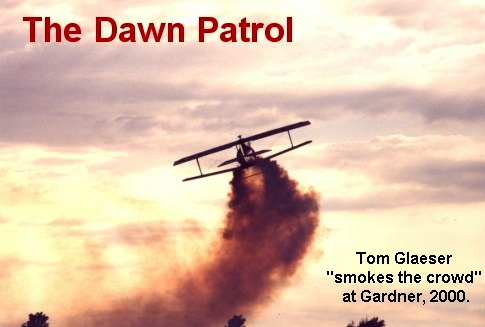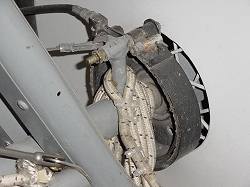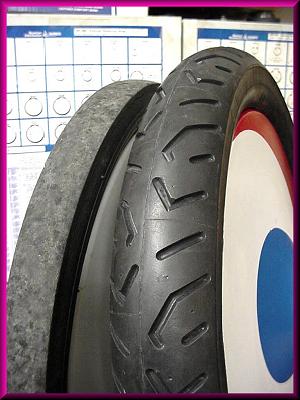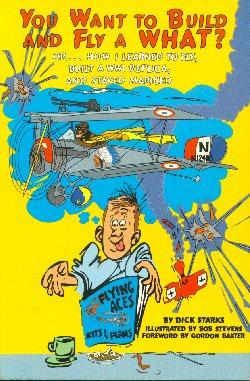 The following is a compilation of just about ALL
the questions we have ever fielded about our fantastic little Nieuport 11 replicas. We've
made so many changes to them that Graham Lee no longer considers them "Graham
Lee" replicas. He also disagrees with some of our opinions on the building and flying
of the birds. But, we stand by what we did and our observations and opinions on their
flight characteristics. The following is a compilation of just about ALL
the questions we have ever fielded about our fantastic little Nieuport 11 replicas. We've
made so many changes to them that Graham Lee no longer considers them "Graham
Lee" replicas. He also disagrees with some of our opinions on the building and flying
of the birds. But, we stand by what we did and our observations and opinions on their
flight characteristics.
At station 97, we made our own custom gusset to cover the sleeve joint. A lot of our gussets were made from scratch after using paper or cardboard to ascertain the size and shape needed. It saved some weight. We did not use the landing gear configuration as shown in the plans for the bottom of the V. We made a sandwich of aluminum plates that were riveted on both sides of the gear legs. It works great and was much easier to do! It is covered in detail in our two video tapes.
We are using a 1835cc. VW power plant with a Culver prop. (60 x 28) The engine is all stock with a Weber PIC-30 or Zenith carb and a Vertex Magneto ignition system. We used baffles to convert the cowl to a pressure cowl configuration. The firewall is 34" in Diameter and leaves ample room for a VW to fit in and rattle around. We are very satisfied with our VWs. I have 495 hours on mine and it's never missed a lick through rain and really hot weather. Mark and I are the only ones who have had to make forced landings and that was not the engine's fault. (Blocked fuel line on Mark's, empty fuel tank on mine.) If we had to do it over, we'd do it with VWs again. We're not pushing them at all at 2650 rpm cruise and they run cool in the hottest of weather. A good pressure cowling is the key. Tom tells me the empty weight of a "bare bones"
VW is 117 lbs. The "bare bones" weight of a VW with manifolds, ignition system,
carb and assorted plumbing is 147-153lbs depending on different configurations. Glenn Huff
is flying his Nieuport 12 with an C-90. If you don't want to build your own engine from scratch, we would recommend contacting Great Plains engines. They offer a quality product at "reasonable" prices. Phone 1-402-493-6507. (Good guys!) The Nieuports are great little planes and fly just like they look. We cruise at about 55-65 mph and land at about 35. Rate of climb is a comfortable 400' per minute with the direct drive VW and with a reduction on a ROTAX 447 or 503 they will really get-up-and-go. They have no bad habits and do everything we want them do to when we ask them to do it. There are no provisions for trim from the cockpit but the aircraft's decalage can be ground adjusted for hands off flight at specific power settings. The planes are very stable in flight and I have flown hands off for thirty and forty minutes at a time when I am just out sight-seeing. If I want to turn, I just stick out my arm and she slowly drags herself around. Hell of a plane!!! We do emphatically recommend that anyone planning on building and flying one of these little jewels take flight training in TAIL DRAGGER type aircraft and be signed off for solo before attempting flight. We would also like to emphasize that in NO WAY do we think these planes are designed or meant for ANY FORM OF AEROBATICS!!!! You old P-51 pilots will just have to do with your memories. The flat airfoil and construction techniques are great for a light weight utility aircraft. The plane is stressed for 3 - 5 POSITIVE Gs depending on the gross weight. We have performed lazy eight's, very mild circling combat and chandelles but firmly believe that no 'intentional' aerobatics that could stress the airframe should be attempted or contemplated. The prototype was stunted but the test pilot was wearing a chute and was doing more of a self test rather than a proof of concept test. He also did this without the designer's knowledge or implied approval. If you want to do aerobatics, get a PITTS. If you want to have a hell of a good time for an embarrassingly moderate price, build a Nieuport. Then when you go to other airports be prepared to stop action and answer a lot of questions. Tom's and my EXPERIMENTAL planes were constructed for an initial total cost of $2859 each (1985-1986 dollars) and were constructed over a period of 16 months. If we had given up on beer we might have done it in a few months less. Mark and Dick's original ROTAX powered Ultralight versions cost $3500-$4000 each. They also took 16 months to construct. The Experimental versions weigh 400-440 pounds empty, have 12 gallon tanks and fly great!! Mark and Dicks original Ultralight versions were not even close to the U.S. legal weight so they finally gave up and went experimental with the VWs. We used the Aircraft Finishing System covering process. It's great AND DOESN'T SMELL UP THE HOUSE!! The planes are all aluminum and utilize aircraft quality self-expanding pull (pop) rivet construction. They are light but very strong. They also easily use a ROTAX engine (447 or 503) or HIRTH. We do not have a materials list and the designer will not give you one either. We just bought as we went along. We did use the optional thicker wall thickness aluminum in the longerons and spars. We are using go-cart style band brakes controlled by a dual cable bicycle type hand lever mounted on the stick. They work great! We tried using feet actuated levers mounted on the rudder bar but after a few exciting sorties through the corn and soybeans, we decided to go with the hand control. We've never regretted it. These little suckers land so slow that the only time you need brakes is to stop while taxiing in. We got out brakes from Northern Hydraulics. (Download the supply sheet that's on the web page.) The Dawn Patrol has two amateur quality video tapes available that we made to try and cover some of the flight characteristics of the plane and also show portions of the airframe construction process that had us stumped a few times. The videos are designed for information and education only and are not "Hollywood" quality or entertainment. "Star Wars" they ain't. |
 We did build the
oversize rudder and heartily recommend using it it until you are used to flying your
plane. Then, when you are comfortable with the plane, you can quickly build the
"standard" sized one. If I had to do it over, I'd still build the larger sized
rudder. The drawing at the right was included in our sets of plans by Graham Lee. It's not
in the newer versions of the plans because Graham doesn't think the larger sized rudder is
necessary. Well.. we've agreed to disagree on that one. Our reasoning is that there is a
short time on takeoff where the very large elevators on the Nieuport can let you
raise the tail off the ground before there is enough airspeed to let the rudder have
enough authority to "bite" and keep you straight. All of us here in Kansas City
have experienced this thrilling little ride and you can kick the rudder against the stops
and it will still do no good. (We call it the "Nieuport Stomp.") We feel the
little extra size that you get is worth it and if you will compare our planes with photos
of other planes, you really can't tell the difference. We feel it's worth it. Graham says
it isn't. You make the call.
We did build the
oversize rudder and heartily recommend using it it until you are used to flying your
plane. Then, when you are comfortable with the plane, you can quickly build the
"standard" sized one. If I had to do it over, I'd still build the larger sized
rudder. The drawing at the right was included in our sets of plans by Graham Lee. It's not
in the newer versions of the plans because Graham doesn't think the larger sized rudder is
necessary. Well.. we've agreed to disagree on that one. Our reasoning is that there is a
short time on takeoff where the very large elevators on the Nieuport can let you
raise the tail off the ground before there is enough airspeed to let the rudder have
enough authority to "bite" and keep you straight. All of us here in Kansas City
have experienced this thrilling little ride and you can kick the rudder against the stops
and it will still do no good. (We call it the "Nieuport Stomp.") We feel the
little extra size that you get is worth it and if you will compare our planes with photos
of other planes, you really can't tell the difference. We feel it's worth it. Graham says
it isn't. You make the call. Our steerable tail wheel's cables connect to the rudder cables just underneath
the seat. We all experienced failures of the lateral tube which joined the forward portion
of the tail skid hoop to the fuselage. Our fix, which the designer does not approve of,
has lasted over 1350 hours of total flight time between all four of our aircraft and shows
no sign of failing at this time. Dick Lemons made the drawing at the right of our tail
wheel steering set up. The dimensions are the basic dimensions. Hole sizes will
depend on your wheel diameter, pivot and axle bolt size, and clevis pin size. Ours are
made from .060" chromolly, and the vertical pieces are wire-welded to the top piece.
There is a heavy fender-washer tac-welded under the pivot hole for added support. It's
held up great for many many hours. (Like over 400!) We're using the 4" tailwheel from
Wicks. There are several lightening-holes in it as well
Our steerable tail wheel's cables connect to the rudder cables just underneath
the seat. We all experienced failures of the lateral tube which joined the forward portion
of the tail skid hoop to the fuselage. Our fix, which the designer does not approve of,
has lasted over 1350 hours of total flight time between all four of our aircraft and shows
no sign of failing at this time. Dick Lemons made the drawing at the right of our tail
wheel steering set up. The dimensions are the basic dimensions. Hole sizes will
depend on your wheel diameter, pivot and axle bolt size, and clevis pin size. Ours are
made from .060" chromolly, and the vertical pieces are wire-welded to the top piece.
There is a heavy fender-washer tac-welded under the pivot hole for added support. It's
held up great for many many hours. (Like over 400!) We're using the 4" tailwheel from
Wicks. There are several lightening-holes in it as well The Nieuport 11 is the model of the plane
we built. The Nieuport 12 is the two seat version. Both planes are built to 7/8th scale.
We are getting 240-50 lbs of measured static thrust out of the direct drive 60 X 28 Culver
prop at 3000 rpm. Right now, they climb at about 400' per minute fully loaded on a hot day
with a fat pilot in the saddle. (me)
The Nieuport 11 is the model of the plane
we built. The Nieuport 12 is the two seat version. Both planes are built to 7/8th scale.
We are getting 240-50 lbs of measured static thrust out of the direct drive 60 X 28 Culver
prop at 3000 rpm. Right now, they climb at about 400' per minute fully loaded on a hot day
with a fat pilot in the saddle. (me) 

 For
those interested, there's a place where you can get tires and tubes for the smaller
Worksman wheels that have almost NO tread and look "kinda" authentic. Dick
Lemons already has them on his plane. The photo at the right is the new tire compared with
one of his old "bike" tires.
For
those interested, there's a place where you can get tires and tubes for the smaller
Worksman wheels that have almost NO tread and look "kinda" authentic. Dick
Lemons already has them on his plane. The photo at the right is the new tire compared with
one of his old "bike" tires.
 I have also had my book published. It is titled, "YOU WANT TO BUILD AND FLY
A WHAT?" and sells for $14.95 plus $2 shipping and handling. It has almost all the
stories I have written about learning to fly and building and flying the Nieuports. If you
are interested in a copy, let me know at the same address as the video tapes. Thanks for
your interest and if you have any questions, feel free to give me a call or e-mail me.
(Not collect for Gods sake.) If you live close to Kansas City, give us a call some weekend
and we will arrange to guide you to Liberty Landing International Airport on the southern
outskirts of beautiful downtown Liberty, Missouri. We are usually down at the airport on
weekends fighting World War One over again and again. I haven't had so much in fun in
years without having to take my clothes off. We'll be glad to see you.
I have also had my book published. It is titled, "YOU WANT TO BUILD AND FLY
A WHAT?" and sells for $14.95 plus $2 shipping and handling. It has almost all the
stories I have written about learning to fly and building and flying the Nieuports. If you
are interested in a copy, let me know at the same address as the video tapes. Thanks for
your interest and if you have any questions, feel free to give me a call or e-mail me.
(Not collect for Gods sake.) If you live close to Kansas City, give us a call some weekend
and we will arrange to guide you to Liberty Landing International Airport on the southern
outskirts of beautiful downtown Liberty, Missouri. We are usually down at the airport on
weekends fighting World War One over again and again. I haven't had so much in fun in
years without having to take my clothes off. We'll be glad to see you.